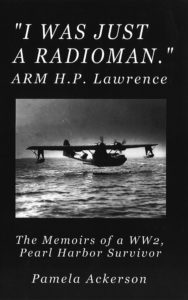 Edited by Pamela Ackerson. Self-published, (2016)
Edited by Pamela Ackerson. Self-published, (2016)
Reviewed by Charles H. Bogart
This self-published monograph was compiled by Ms. Ackerson to preserve the family history of Aviation Chief Radioman Henry Lawrence’s service in World War II. The audience at which the book is directed is family and friends. Henry Lawrence, in June 1940 at the age of seventeen, joined the U.S. Navy Reserve unit at Newport, Rhode Island. On 12 May 1941, he was called to active duty and sent to Aviation Radio School at NAS Sand Point outside of Seattle, Washington. On 19 November 1941, he arrived in Hawaii as an Aviation Radioman and was assigned to VP 22 located on Ford Island. VP 22 at this time was flying PBY-5 Catalina flying boats.
Chief Lawrence’s tale of the Japanese attack on Pearl Harbor is told in six pages, which add little to what has already been written about the 7 December 1941 Japanese attack on Ford Island. His service in the Pacific Theater from 1943 to 1945 was as a radioman on board PBY-5 Catalinas of VPB 71. His service in VPB 71 is told through a series of vignettes that focus on the carrying out of nocturnal patrols in the waters of the Southwest Pacific and off the coast of Formosa. These flights, Black Cat Missions, were carried out by flying at 1,000 feet above the sea, searching for Japanese merchant ships to attack. These vignettes are full of nuggets of information about U.S. Navy Black Cat operations during World War II.
Chief Lawrence’s account of his service in World War II ends with “The war’s over! I will thank Colonel Paul Tibbets, his Enola Gay, and celebrate August 14th for the rest of my life.” Once discharged from the Navy, Chief Lawrence spent the next 18-years in the Naval Reserves.
This book is an interesting read, but I suspect that only the hard-core World War II naval aviation aficionado will place this book in his library.
Charles Bogart is a frequent contributor to Naval History Book Reviews.

